The SK Hynix Gold S31 SATA SSD Review: Hynix 3D NAND Finally Shows Up
by Billy Tallis on November 13, 2019 12:00 PM ESTSequential Read Performance
Our first test of sequential read performance uses short bursts of 128MB, issued as 128kB operations with no queuing. The test averages performance across eight bursts for a total of 1GB of data transferred from a drive containing 16GB of data. Between each burst the drive is given enough idle time to keep the overall duty cycle at 20%.
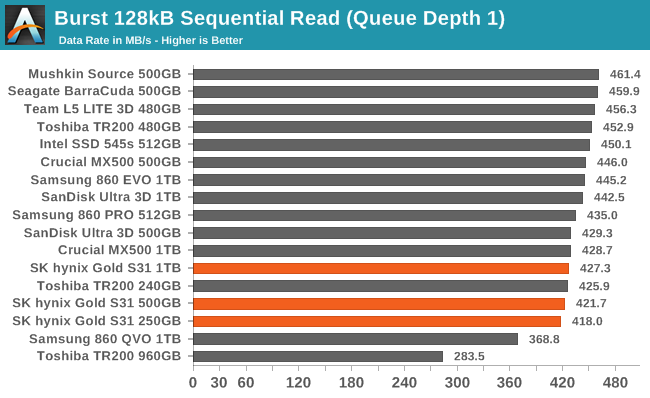
The burst sequential read performance of all three capacities of the SK Hynix Gold S31 are a bit on the slow side, but from the smallest and slowest S31 up to the fastest SATA drive in this batch is a mere 10%.
Our test of sustained sequential reads uses queue depths from 1 to 32, with the performance and power scores computed as the average of QD1, QD2 and QD4. Each queue depth is tested for up to one minute or 32GB transferred, from a drive containing 64GB of data. This test is run twice: once with the drive prepared by sequentially writing the test data, and again after the random write test has mixed things up, causing fragmentation inside the SSD that isn't visible to the OS. These two scores represent the two extremes of how the drive would perform under real-world usage, where wear leveling and modifications to some existing data will create some internal fragmentation that degrades performance, but usually not to the extent shown here.
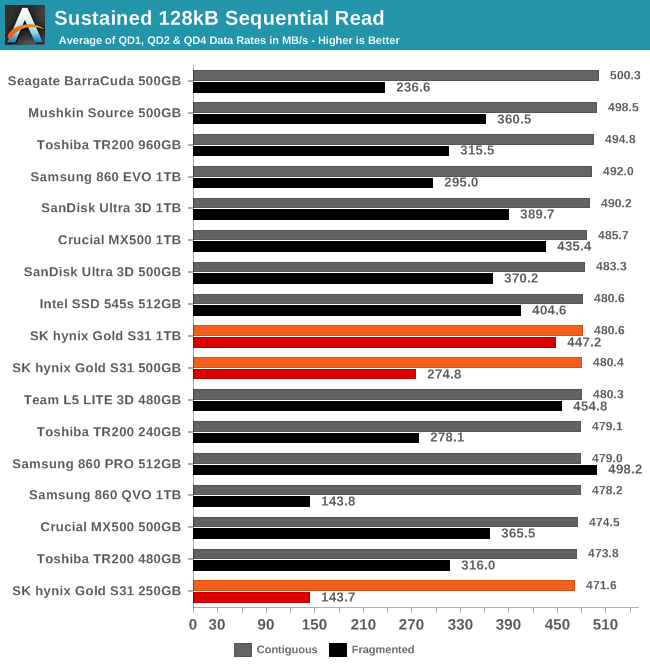
On the longer sequential read test that brings in some moderately higher queue depths, all the SATA drives perform similarly for reading data that was written sequentially. When performing sequential reads of data that was written randomly, the 1TB S31 performs quite well but the smaller models suffer significantly.
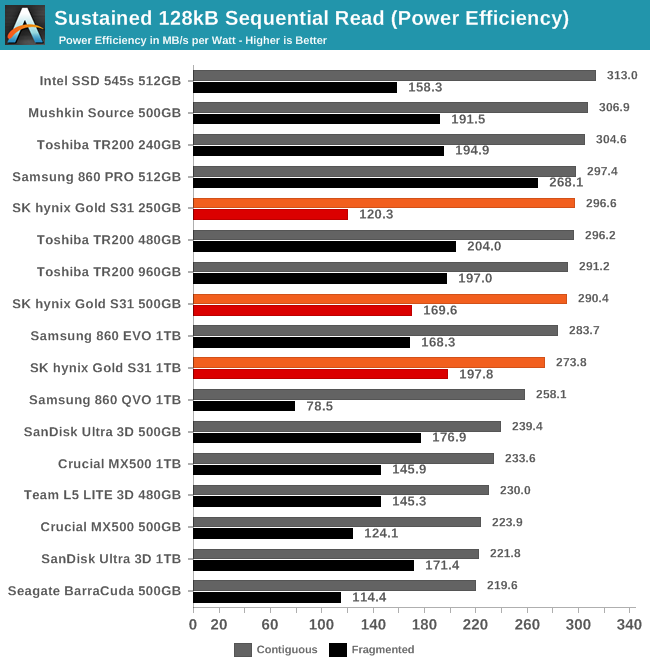 |
|||||||||
| Power Efficiency in MB/s/W | Average Power in W | ||||||||
The power efficiency of the S31 doesn't stand out on the sequential read test. It doesn't consume much less power than the competition, and with the performance scores showing little variation across the entire field, the efficiency scores for the S31 are good but nothing special.
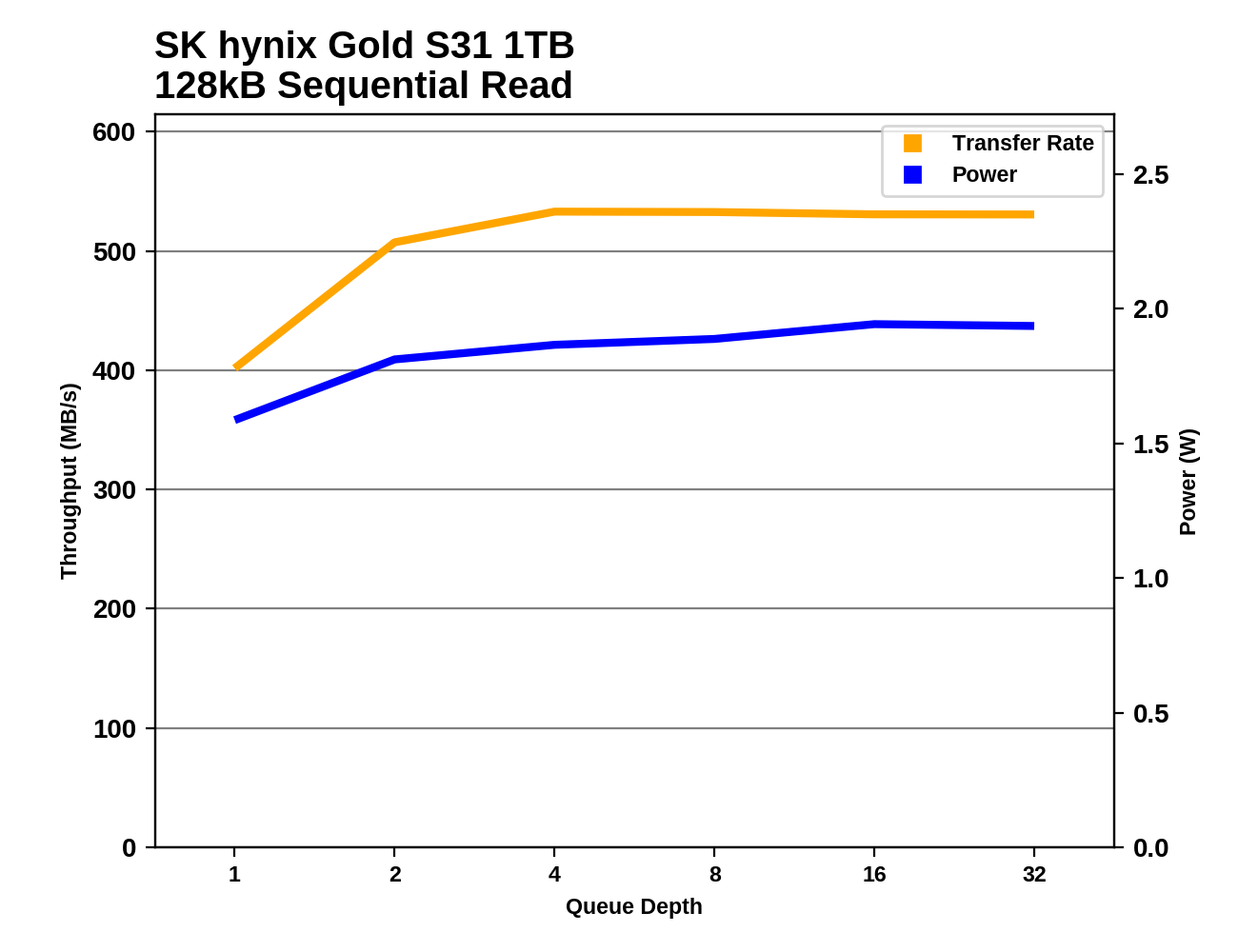 |
|||||||||
The S31 drives don't quite reach full sequential read speed until QD4. The larger two models perform identically across the entire range of queue depths, with the 1TB model consistently drawing a bit more power than the 500GB model. The 250GB model has a slight performance blip or two but otherwise it also matches the performance of the other two drives.
The power usage of the 1TB S31 during the sequential read test is a bit less than average, but unlike for the random IO tests it isn't standing at the limits of what is currently achievable
Sequential Write Performance
Our test of sequential write burst performance is structured identically to the sequential read burst performance test save for the direction of the data transfer. Each burst writes 128MB as 128kB operations issued at QD1, for a total of 1GB of data written to a drive containing 16GB of data.
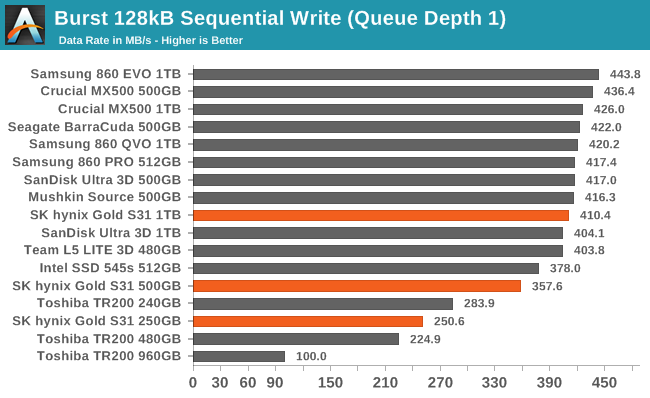
On the burst sequential write test, the 1TB SK Hynix Gold S31 turns in a decent score. The 500GB model is a little bit slower, and the 250GB S31 manages to be a bit slower than the DRAMless Toshiba TR200.
Our test of sustained sequential writes is structured identically to our sustained sequential read test, save for the direction of the data transfers. Queue depths range from 1 to 32 and each queue depth is tested for up to one minute or 32GB, followed by up to one minute of idle time for the drive to cool off and perform garbage collection. The test is confined to a 64GB span of the drive.
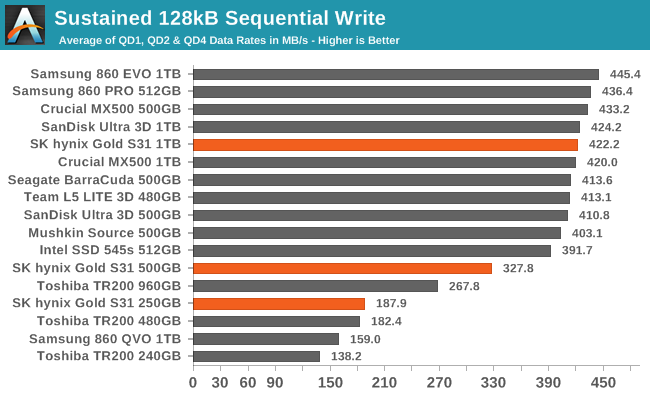
On the longer sequential write test, the 1TB S31 improves its standing to keep up with its like-sized competition while the 500GB model clearly falls behind.
 |
|||||||||
| Power Efficiency in MB/s/W | Average Power in W | ||||||||
The larger two capacities of the S31 earn decent power efficiency scores during the sequential write test, but they aren't in the top tier of drives. The 250GB model averaged less power draw than any of the other drives in this batch, but its poor performance keeps the overall efficiency score low.
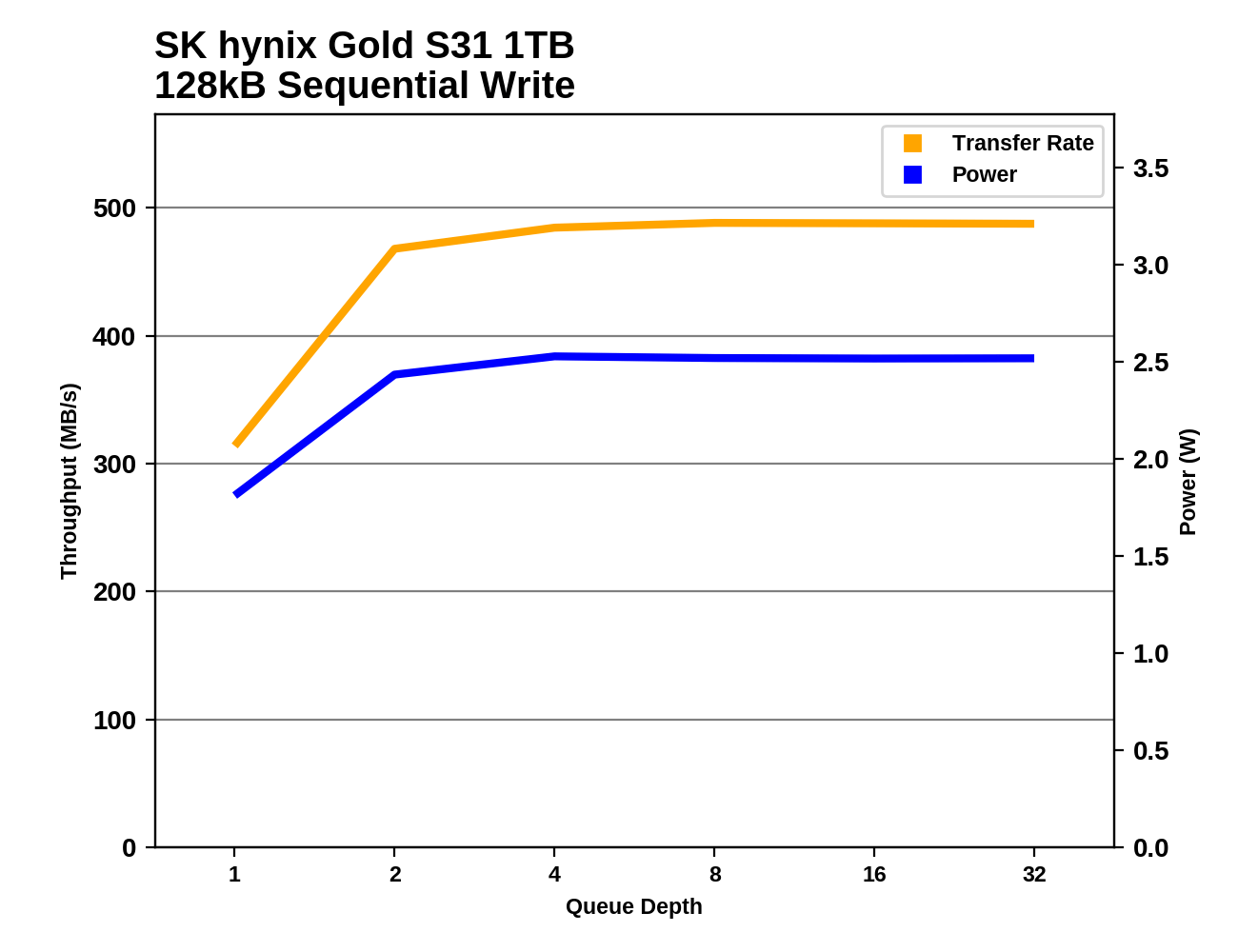 |
|||||||||
While getting full sequential read speeds out of the S31 required sufficiently high queue depths, the 500GB model is basically at its full speed at QD2 and the 250GB hardly gains anything from going past QD1.
As with sequential reads, the record of all sequential writes shows that the S31 is fairly average when it comes to power draw, and there's room for improvement.



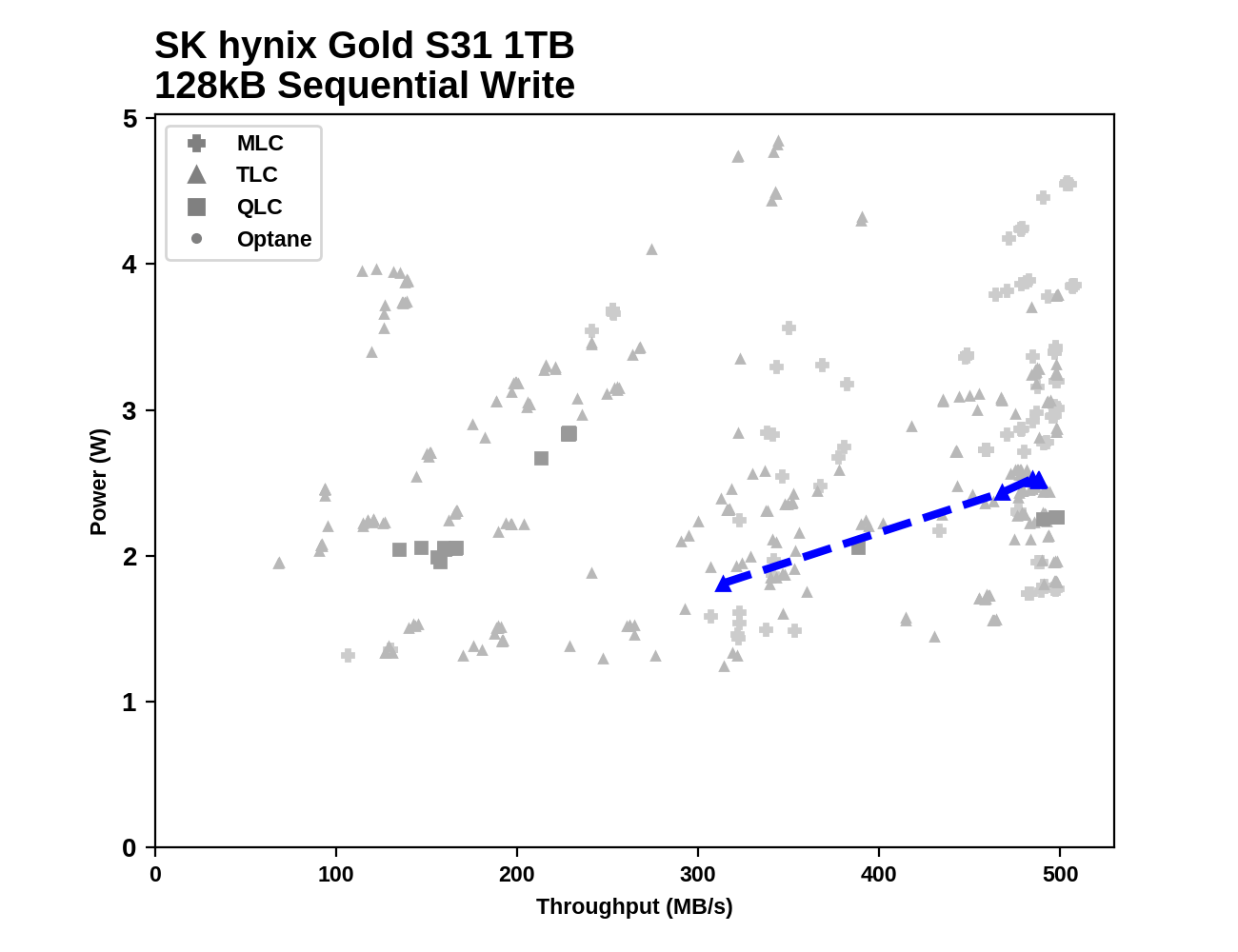








22 Comments
View All Comments
MenhirMike - Wednesday, November 13, 2019 - link
We're not going to get under 10c/GB anytime soon, will we? SATA SSDs seem to be stagnant - performance is OK, power consumtion is OK, price is $100 for 1TB, endurance is the usual 0.3 WPD - and yet there are constantly new products with different components and basically the same performance/power/price.Is there a limitation that currently causes stagnation? (I know that SATA is inherently limited in performance, but price shouldn't be stagnant if the main need in that sector is more capacity for less money, with performance/power/endurance being the same)
FunBunny2 - Wednesday, November 13, 2019 - link
"price shouldn't be stagnant if the main need in that sector is more capacity for less money"all of these companies face the Tyranny of Fixed Cost, i.e. the BoM is almost all amortization of the plant and equipment to make the various bits and pieces. sand, some chemicals, and a watchman or two to hover over the machines amount to the variable cost. in such a situation, the only way to lower *average cost* (and shut up the bean counters) is to ship more product and thus spread the fixed cost a tad thinner. lots more product. but that, in turn, is strictly limited by user demand. they're caught between a rock and a hard place. they end up viewing the situation as zero-sum game; one can win only if the other(s) lose when there's little to no global (in every sense of the word) growth. welcome to Earthly Stagnation.
dromoxen - Thursday, November 14, 2019 - link
Having Dr ManHattan looking after your machines is a very expensive business , Rorschach is very unreliable too.eek2121 - Wednesday, November 13, 2019 - link
Except prices have been falling. You just don't realize it because it happens over time.These drives are as cheap as Samsung's QLC drives, without the disadvantages.
Slash3 - Wednesday, November 13, 2019 - link
SSD prices have been basically flat since October/November 2018. Check the price tracking for a 500GB/1TB MX500 or 860 Evo and there have been a few variations but nothing substantial or permanent.I'd love to pick up more large capacity solid state to replace some of my HDDs, but I bought two 2TB SSDs over a year ago and they're actually a few dollars *more* expensive now.
At this point, it may actually be cheaper to build a large NAS using MicroSD cards...
eek2121 - Wednesday, November 13, 2019 - link
I paid the same amount for my 2 TB 970 evo as I did my 1 TB 960 evo 2.5-3 years ago. Also, don't track specific drivers, look at charts. NAND is coming down. It just takes time.Slash3 - Wednesday, November 13, 2019 - link
/s implied with respect to the MicroSD card NAS, if it weren't obvious.Although that would be fun to build.
nandnandnand - Wednesday, November 13, 2019 - link
Sale prices are hitting 8c/GB. Don't pay 10c/GB if you live in America. As the average drive capacity goes up, the prices will continue to go down.Thankfully, 100 GB and larger games are a thing, so that should create some demand.
deil - Thursday, November 14, 2019 - link
we might PLC coming soon, so we might see some 1 TB/1.5 TB/2TB/3TB sata's soon and as they are 20% bigger after amortization wears off, almost 20% cheaper it will become.main focus will go to PCIE4.0 now though. so I would say next December expect 2 or 3 products with same nand. 120GB/240 will not go lower than its is now.
deil - Thursday, November 14, 2019 - link
in there on the article. We already did on 1 TB ones. and PLC will go even lower.ADATA SU800 $34.99
(14¢/GB) $57.99
(11¢/GB) $91.99
(9¢/GB) $209.99
(10¢/GB)